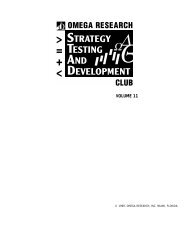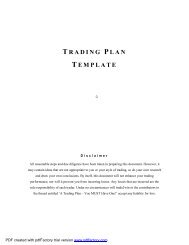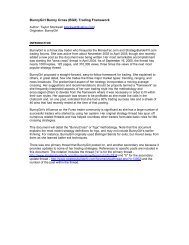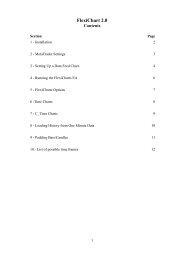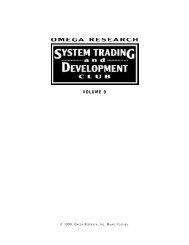the trader's classroom collection
the trader's classroom collection
the trader's classroom collection
You also want an ePaper? Increase the reach of your titles
YUMPU automatically turns print PDFs into web optimized ePapers that Google loves.
III. How <strong>the</strong> Wave Principle Fits Certain Trading Styles: Corrective Patterns<br />
Figure 3-12<br />
3. Triangles<br />
Triangles are probably <strong>the</strong> easiest corrective wave pattern to identify, because prices simply trade sideways during <strong>the</strong>se<br />
periods. Figure 3-13 shows <strong>the</strong> different shapes triangles can take, although I find <strong>the</strong> symmetrical or contracting variety<br />
most common. While <strong>the</strong>y may be easy to spot, <strong>the</strong>y can be nasty little fellows, too. To an options trader, triangles<br />
represent time decay (and no price movement), which decreases an option’s value.<br />
Depending on a triangle’s size, it can represent to futures traders <strong>the</strong> depletion of what I call “emotional capital.” Let me<br />
explain. As a trader, your trading account represents one form of capital (dollars), while your state of mind represents<br />
ano<strong>the</strong>r (emotions). Have you ever had a losing trade that was devastating or a series of losers that made you question<br />
yourself or your methodology? Too often, <strong>the</strong> result is that you ei<strong>the</strong>r hesitate or pass on <strong>the</strong> next signal. Triangles,<br />
especially <strong>the</strong> big ones with wide price swings, can eat away at your emotional capital, because you don’t know if <strong>the</strong><br />
market is going to go your way, or if you’ll be stopped out of <strong>the</strong> position. Often, a negative frame of mind translates into<br />
bad trading decisions or missed opportunities.<br />
Although sometimes troublesome, triangles offer an important piece of forecasting information – <strong>the</strong>y only occur just<br />
prior to <strong>the</strong> final wave of a sequence. This is why triangles are strictly limited to <strong>the</strong> wave four, B or X positions. In o<strong>the</strong>r<br />
words, if you run into a triangle, you know <strong>the</strong> train is coming into <strong>the</strong> station.<br />
The Trader’s Classroom Collection — published by Elliott Wave International — www.elliottwave.com<br />
13





